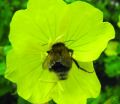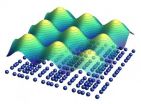It must be important but what does it do? The strange case of UCP2
2012-08-17
(Press-News.org) When uncoupling proteins are active, mitochondria produce heat instead of ATP. This may be useful under certain circumstances, such as when an animal is hibernating. But non-hibernating animals also have them. Particularly poorly understood is the uncoupling protein UCP2. Elena Pohl and colleagues at the University of Veterinary Medicine, Vienna, show that the protein occurs mainly in cells of the immune system. The group's highly provocative findings are published in the online journal PLOS ONE.
Mitochondria represent the powerhouses of the eukaryotic cell. They are able to use the primary product of the breakdown of sugars to generate a proton gradient across their inner membrane and to exploit this gradient to produce ATP, which drives cellular metabolism. The importance of mitochondria to higher life forms is clear from what happens when their function is blocked: many poisons, such as cyanide, are known to act in this manner.
In this light, the discovery in 1973 of a eukaryotic protein that dissipates the proton gradient without generating ATP was highly unexpected. When this protein, thermogenin, is active, mitochondria produce heat rather than ATP. We now know that thermogenin is merely one member of a family of so-called 'uncoupling proteins' that can use proton gradients to generate heat. The founder member of the family, thermogenin, has been renamed uncoupling protein 1 or UCP1 and is known to be important in helping animals keep warm during hibernation and for babies to maintain their body temperature. The actions of the other members of the family are less well understood. Particularly enigmatic is UCP2 but important clues to its function have now been provided by Anne Rupprecht and colleagues in the Institute of Physiology at the University of Veterinary Medicine, Vienna. Together with collaboration partners in Germany and Sweden, the researchers carefully examined the distribution of the UCP2 protein in mice. Their results showed clearly that UCP2 was preferentially expressed in cells related to the immune system and not, as generally believed, in neurons.
The implication was that UCP2 might somehow be involved in immune function. This surprising idea was tested by examining the change in UCP2 levels in T cells that were stimulated into action by a specific antigen. Stimulation indeed caused an increase in the amount of UCP2 in the cells. This was paralleled by increases in the concentrations of other proteins known to be produced in response to T-cell activation. When the cells were further stimulated seven and fourteen days later the amount of UCP2 increased although the amounts of the other proteins investigated did not.
It is attractive to speculate that the increase in UCP2 might be involved in signalling T-call stimulation but Pohl is quick to quash the notion. "Anne showed that the increase in UCP2 only starts a few hours after activation of T cells, while other events are seen much sooner. UCP2 thus arrives too late to be involved in stimulating the cells, so the increase must be related to overall metabolic changes in proliferating cells. This fits with our observation that UCP2 is not found in neurons, which no longer proliferate" In other words, although we still cannot be sure of the exact function of this intriguing protein, "at least we now know where to start looking!" And the finding that UCP2 is required by fast proliferating cells may have important consequences for the development of treatments for immune disorders, such as autoimmune and neurodegenerative diseases, and perhaps also for other diseases where cells divide rapidly, such as cancer.
INFORMATION:
The paper Quantification of Uncoupling protein 2 reveals its main expression in immune cells and selective up-regulation during T-cell proliferation by Anne Rupprecht, Anja U. Bräuer, Alina Smorodchenko, Justus Goyn, Karolina E. Hilse, Irina Shabalina, Carmen Infante-Duarte and Elena E. Pohl has just been published by the open access journal PLOS ONE.
The scientific article in full text online (Open Access):
http://dx.plos.org/10.1371/journal.pone.0041406
About the Vienna University of Veterinary Medicine
The University of Veterinary Medicine, Vienna is the only academic and research institution in Austria that focuses on the veterinary sciences. About 1000 employees and 2300 students work on the campus in the north of Vienna, which also houses the animal hospital and various spin-off-companies.
http://www.vetmeduni.ac.at
Scientific contact:
Prof. Elena Pohl
Unit of Physiology and Biophysics
University of Veterinary Medicine, Vienna
M +43 650 366 3205
Elena.Pohl@vetmeduni.ac.at
Distributed by:
Klaus Wassermann
Public Relations/Science Communication
University of Veterinary Medicine, Vienna
T +43 1 25077-1153
klaus.wassermann@vetmeduni.ac.at
END
ELSE PRESS RELEASES FROM THIS DATE:
2012-08-17
Santa Cruz, California—Scientists have sequenced the genome of one of the iconic Galapagos finches first described by Charles Darwin. The genome of the medium ground finch (Geospiza fortis) is among the first of a planned 100 genomes of vertebrate species to be sequenced and released by an international collaboration between the Genome 10K project and BGI.
This finch genome, the first of the BGI-Genome 10K collaboration to be made available through the UCSC Genome Browser, represents both a scientific and a symbolic advancement, according to Duke University associate professor ...
2012-08-17
New research, led by University of Warwick physicist Dr Kareem Osman, has provided significant insight into how the solar wind heats up when it should not. The solar wind rushes outwards from the raging inferno that is our Sun, but from then on the wind should only get cooler as it expands beyond our solar system since there are no particle collisions to dissipate energy. However, the solar wind is surprisingly hotter than it should be, which has puzzled scientists for decades. Two new research papers led by Dr Osman may have solved that puzzle.
Turbulence pervades ...
2012-08-17
Most people are not aware of the fact that 84% of the European crops are partially or entirely dependent on insect pollination. While managed honeybees pollinate certain crops, wild bees, flies and wasps cover a very broad spectrum of plants, and thus are considered the most important pollinators in Europe.
The serious decline in the number of managed honeybees and wild bees reported in Europe over the last few decades has the potential to cause yield decreases with threats to the environment and economy of Europe. The future of the pollination services provided by bees ...
2012-08-17
A large-scale survey of the mental condition of military personnel before, during and after their posting to Afghanistan has proved thought-provoking. In total, 746 Danish soldiers took part in the survey. The soldiers completed a questionnaire five times in all – before their posting, during their time in Afghanistan and three times after their return to Denmark.
Professor Dorthe Berntsen of the Center on Autobiographical Memory Research – CON AMORE, Department of Psychology, Aarhus University, Business and Social Sciences, is responsible for the study, together with ...
2012-08-17
Researchers in India have developed a total cholesterol test that uses a digital camera to take a snapshot of the back of the patient's hand rather than a blood sample. The image obtained is cropped and compared with images in a database for known cholesterol levels.
Writing in the International Journal of Medical Engineering and Informatics, N.R. Shanker of the Sree Sastha Institute of Engineering and Technology and colleagues describe how they have developed a non-invasive way to test cholesterol levels in patients at increased risk of heart disease. Their approach ...
2012-08-17
TORONTO, Aug. 17, 2012--When members of the public participate in research studies, they are often given incentives – such as cash or gift cards for food – as compensation or reimbursement for their time and effort. Not so for Canada's prison population. A new analysis shows that there is inconsistency in how and when incentives are used for research participants under criminal justice supervision.
Of the provinces, territories and federal government, only two jurisdictions have written policy around the use of research incentives, according to a national study led by ...
2012-08-17
Whether a material conducts electricity without losses is not least a question of the right temperature. In future it may be possible to make a more reliable prediction for high-temperature superconductors. These materials lose their resistance if they are cooled with liquid nitrogen, which is relatively easy to handle. An international team, in which physicists of the Max Planck Institute for Solid State Research in Stuttgart played a crucial role, has now discovered that this form of superconductivity competes with charge density waves, i.e. with a periodically fluctuating ...
2012-08-17
VIDEO:
A Spanish researcher has proposed human, agricultural and livestock waste, such as urine, as a way to absorb CO2.
Click here for more information.
The ocean, the ground, rocks and trees act as carbon drains but are far from places where greenhouses gases are concentrated, especially CO2. A Spanish researcher has proposed human, agricultural and livestock waste, such as urine, as a way to absorb this gas.
Absorbing the large quantities of carbon dioxide and other greenhouse ...
2012-08-17
EAST LANSING, Mich. --- Two new species of owls have been discovered in the Philippines, and a Michigan State University researcher played a key role in confirming their existence.
The discovery, which is featured in the current issue of Forktail, the Journal of Asian Ornithology, took years to confirm, but it was well worth the effort, said the paper's lead author Pam Rasmussen, MSU assistant professor of zoology and assistant curator of mammalogy and ornithology at the MSU Museum.
"More than 15 years ago, we realized that new subspecies of Ninox hawk-owls existed ...
2012-08-17
CAMBRIDGE, MA -- A penny-sized rocket thruster may soon power the smallest satellites in space.
The device, designed by Paulo Lozano, an associate professor of aeronautics and astronautics at MIT, bears little resemblance to today's bulky satellite engines, which are laden with valves, pipes and heavy propellant tanks. Instead, Lozano's design is a flat, compact square — much like a computer chip — covered with 500 microscopic tips that, when stimulated with voltage, emit tiny beams of ions. Together, the array of spiky tips creates a small puff of charged particles that ...
LAST 30 PRESS RELEASES:
[Press-News.org] It must be important but what does it do? The strange case of UCP2


